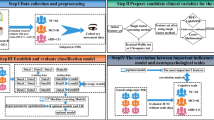Abstract
In this text we compare the measurement results of reflexive saccades and antisaccades of patients with Parkinson’s Disease (PD), trying to determine the best settings to predict the Unified Parkinson’s Disease Rating Scale (UPDRS) results. After Alzheimer’s disease, PD statistically is the second one and until today, no effective therapy has been found. Luckily, PD develops very slowly and early detection can be very important in slowing its progression. In this experiment we examined the reflective saccades (RS) and antisaccades (AS) of 11 PD patients who performed eye-tracking tests in controlled conditions. We correlated neurological measurements of patient’s abilities described by the Unified Parkinson’s Disease Rating Scale (UPDRS) scale with parameters of RS and AS. We used tools implemented in the Scikit-Learn for data preprocessing and predictions of the UPDRS scoring groups [1]. By experimenting with different datasets we achieved best results by combining means of RS and AS parameters into computed attributes. We also showed, that the accuracy of the prediction increases with the number of such derived attributes. We achieved 89% accuracy of predictions and showed that computed attributes have 50% higher results in the feature importance scoring than source parameters. The eye-tracking tests described in this text are relatively easy to carry out and could support the PD diagnosis.
Access this chapter
Tax calculation will be finalised at checkout
Purchases are for personal use only
Similar content being viewed by others

References
Pedregosa, F.: Scikit-learn: machine learning in python. J. Mach. Learn. Res. 12, 2825–2830 (2011)
McKinney, W., et al.: Data structures for statistical computing in python. In: Proceedings of the 9th Python in Science Conference, vol. 445, pp. 51–56 (2010)
Hallett, P.E., Adams, B.D.: The predictability of saccadic latency in a novel voluntary oculomotor task. Vision. Res. 20(4), 329–339 (1980)
Purves, D., Augustine, G.J., Fitzpatrick, D., et al. (eds.): Types of Eye Movements and Their Functions. Neuroscience, 2nd edn. Sinauer Associates Inc, Sunderland (2001)
Pratt, J., Abrams, R., Chasteen, A.: Initiation and inhibition of saccadic eye movements in younger and older adults an analysis of the gap effect. J. Gerontol.: Psychol. Sci. 52B(2), 1O3–1O7 (1997)
Robinson, D.A.: Control of eye movements. In: Handbook of Physiology, Section I: The Nervous System. American Physiological Society, Bethesda (1981)
Bhidayasiri, R., Martinez-Martin, P.: Clinical assessments in Parkinson’s disease: scales and monitoring. In: International Review of Neurobiology, vol. 132, pp. 129–182 (2017)
Olk, B., Kingstone, A.: Why are antisaccades slower than prosaccades? A novel finding using a new paradigm. Cogn. Neurosci. Neuropsychol. 14(1), 151–155 (2003)
Kitagawa, M., Fukushima, J., Tashiro, K.: Relationship between antisaccades and the clinical symptoms in Parkinson’s disease. Neurology 44(12), 2285 (1994)
Hood, A.J., Amador, S.C., Cain, A.E., et al.: Levodopa slows prosaccades and improves antisaccades, an eye movement study in Parkinson’s disease. J. Neurol. Neurosurg. Psychiatry 78, 565–570 (2007)
Everling, S., DeSouza, J.F.X.: Rule-dependent activity for prosaccades and antisaccades in the primate prefrontal cortex. J. Cogn. Neurosci. 17(9), 1483–1496 (2005)
Nakamura, T., Funakubo, T., Kanayama, R., Aoyagi, M.: Reflex saccades, remembered saccades and antisaccades in Parkinson’s disease. J. Vestib. Res. 4(6), S32 (1996). (Suppl. 1)
Everling, S., Fischer, B.: The antisaccade: a review of basic research and clinical studies. Neuropsychologia 36(9), 885–899 (1998)
Przybyszewski, A., Szlufik, S., Szymanski, A., Habela, P., Koziorowski, D.: Multimodal learning and intelligent prediction of symptom development in individual Parkinson’s patients. Sensors 16(9), 1498 (2016)
Saslow, M.G.: Effects of components of displacement-step stimuli upon latency for saccadic eye movement. J. Opt. Soc. Am. 57(8), 1024–1029 (1967)
Chu, C., Hsu, A.-L., Chou, K.-H., Bandettini, P., Lin, C.: Does feature selection improve classification accuracy? Impact of sample size and feature selection on classification using anatomical magnetic resonance images. NeuroImage 60(1), 59–70 (2012)
Author information
Authors and Affiliations
Corresponding author
Editor information
Editors and Affiliations
Ethics declarations
This study was carried out in accordance with the recommendations of Bioethics Committee of Warsaw Medical University with written informed consent from all subjects. All subjects gave written informed consent in accordance with the Declaration of Helsinki. The protocol was approved by the Bioethics Committee of Warsaw Medical University.
Rights and permissions
Copyright information
© 2020 Springer Nature Switzerland AG
About this paper
Cite this paper
Śledzianowski, A., Szymanski, A., Drabik, A., Szlufik, S., Koziorowski, D.M., Przybyszewski, A.W. (2020). Combining Results of Different Oculometric Tests Improved Prediction of Parkinson’s Disease Development. In: Nguyen, N., Jearanaitanakij, K., Selamat, A., Trawiński, B., Chittayasothorn, S. (eds) Intelligent Information and Database Systems. ACIIDS 2020. Lecture Notes in Computer Science(), vol 12034. Springer, Cham. https://doi.org/10.1007/978-3-030-42058-1_43
Download citation
DOI: https://doi.org/10.1007/978-3-030-42058-1_43
Published:
Publisher Name: Springer, Cham
Print ISBN: 978-3-030-42057-4
Online ISBN: 978-3-030-42058-1
eBook Packages: Computer ScienceComputer Science (R0)



